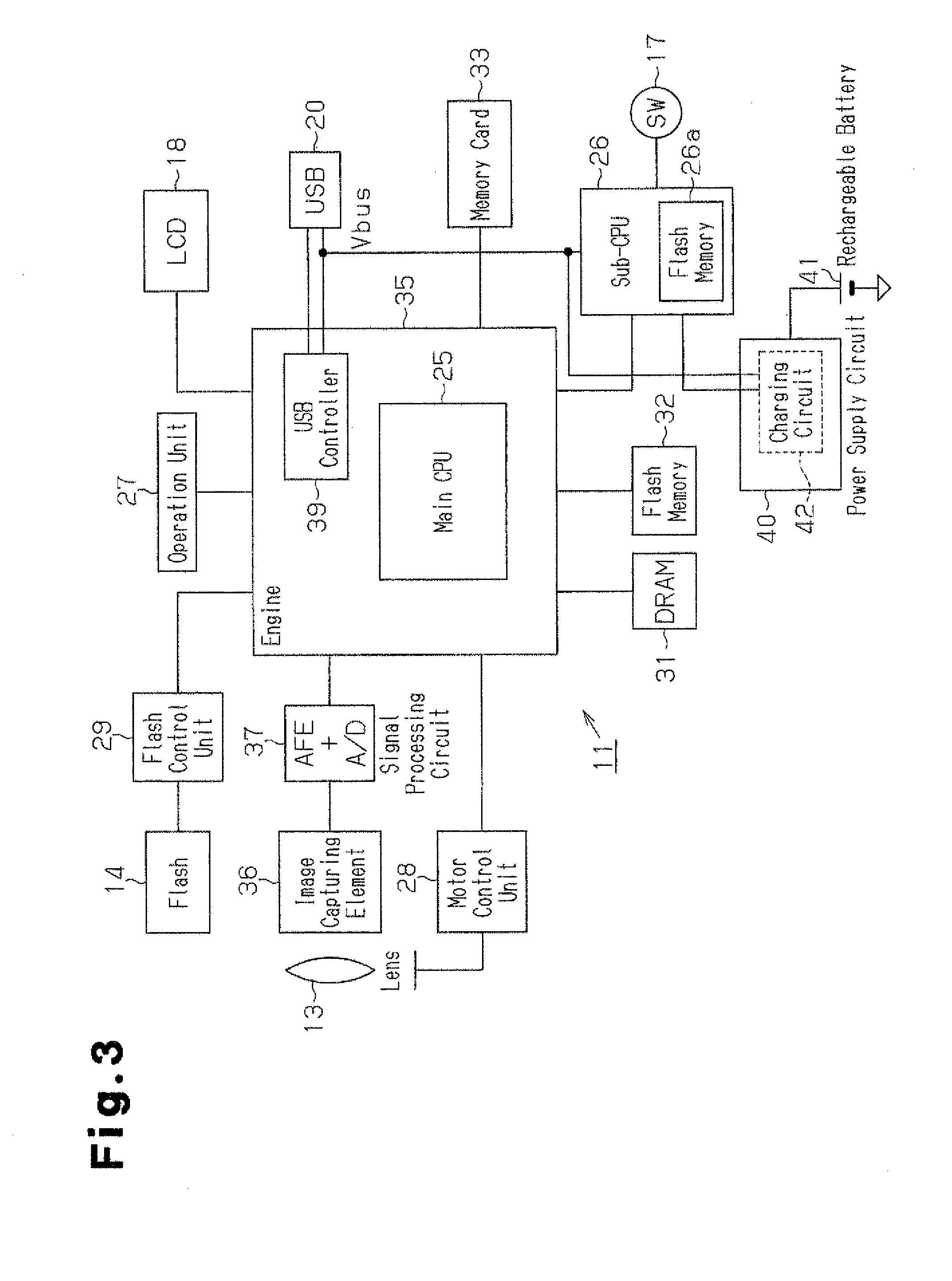Charger for electronic device, electronic device, and charging method
a technology of electronic devices and chargers, applied in electric vehicles, electric power, transportation and packaging, etc., can solve the problems of inability to acquire information (specified voltage, specified current, etc.) necessary for charging from the connected electronic device, and the inability of electronic devices to perform usb communication,
- Summary
- Abstract
- Description
- Claims
- Application Information
AI Technical Summary
Benefits of technology
Problems solved by technology
Method used
Image
Examples
first embodiment
[0023]An electronic device according to a first embodiment of the present invention will now be discussed with reference to FIGS. 1 to 5. Here, the electronic device is an electronic still camera 11.
[0024]As shown in FIG. 1, the electronic still camera 11 (digital still camera) of the present embodiment includes a camera body 12 having the shape of a rectangular cuboid. An image capturing lens unit 13 is arranged in the front central part of the camera body 12. A flash 14 (strobe light emitting unit) and an emission window 15 are arranged on the camera body 12 at two locations above the image capturing lens unit 13. The emission window 15 emits infrared light, ultrasonic waves, or the like towards a subject to perform focusing.
[0025]A release button 16, which a photographer pushes (i.e., activates) when initiating an image capturing operation with the electronic still camera 11, is arranged at the left end on the upper surface of the camera body 12 as viewed in FIG. 1. A power switc...
second embodiment
[0086]A second embodiment will now be discussed with reference to FIG. 6. The second embodiment differs from the first embodiment in that the main CPU 25 is activated to acquire the standard-specified current information (specified power supply information) of another electronic device serving as the connection origin with the USB communication. Otherwise, the structure of the electronic still camera 11 is the same as the first embodiment. Thus, only the contents of the charging control process will be described below in detail. In the present embodiment, at least the main CPU 25, the sub-CPU 26, and the power supply circuit 40 form the charger for charging the rechargeable battery 41.
[0087]Referring to FIG. 6, when the sub-CPU 26 detects connection of the USB cable 21 (affirmative determination in step S210) and determines that the temperature of the rechargeable battery 41 is in a chargeable range (affirmative determination in step S220), the sub-CPU 26 proceeds to step S230 and a...
third embodiment
[0093]A third embodiment will now be discussed with reference to FIG. 7. In the third embodiment, the measurement value differs from each of the above-described embodiments. More specifically, in each of the embodiments described above, the sub-CPU 26 controls the charging current amount Ib by directly using the measurement value (measurement voltage Vm). In the third embodiment, the sub-CPU 26 determines the voltage drop amount and the voltage drop rate based on the measurement (measurement voltages Vm and Vp) of the power supply voltage Vbus to control the charging current amount Ib using at least one of the voltage drop amount and the voltage drop rate as the measurement value. Otherwise, the structure of the electronic still camera 11 is the same as the first embodiment. Thus, only the contents of the charging control process will be discussed below in detail.
[0094]As shown in FIG. 7, the processes of steps S510 to S550 and S660 are similar to the processes of steps S10 to S50 a...
PUM
 Login to View More
Login to View More Abstract
Description
Claims
Application Information
 Login to View More
Login to View More - R&D
- Intellectual Property
- Life Sciences
- Materials
- Tech Scout
- Unparalleled Data Quality
- Higher Quality Content
- 60% Fewer Hallucinations
Browse by: Latest US Patents, China's latest patents, Technical Efficacy Thesaurus, Application Domain, Technology Topic, Popular Technical Reports.
© 2025 PatSnap. All rights reserved.Legal|Privacy policy|Modern Slavery Act Transparency Statement|Sitemap|About US| Contact US: help@patsnap.com



